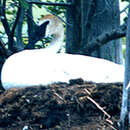Cool facts
provided by EOL authors
The largest of North American waterfowl, the Trumpeter Swan is resident throughout much of its range, but migratory in other parts. Its was reduced to near extinction by the early 20th century, but it is relatively common today. The Trumpeter Swan was hunted for its feathers throughout the 1600s - 1800s, causing a tremendous decline in its numbers. Its largest flight feathers made what were considered to be the best quality quill pens. Swans can live a long time. Wild Trumpeter Swans have been known to live longer than 24 years, and one captive individual lived to be 32. Trumpeter Swans form pair bonds when they are three or four years old. The pair stays together throughout the year, moving together in migratory populations. Trumpeters are assumed to mate for life, but some individuals do switch mates over their lifetimes. Some males that lost their mates did not mate again.
- bibliographic citation
- Trumpeter Swan (Cygnus buccinator). The Cornell Lab of Ornithology All About Birds. http://www.allaboutbirds.org/guide/Trumpeter_Swan/lifehistory. Accessed 28 Jan 2014.
- author
- J Medby (jamiemedby)

